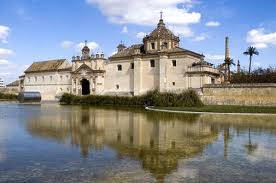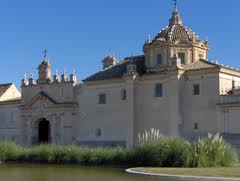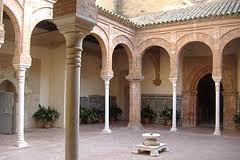Andalusian Contemporary Arts Center
Where: Monasterio de la Cartuja de Santa María de Las Cuevas, entrance in Avda. Américo Vespucio, 2 | Camino de los Descubrimientos, s/n, 41092
Opening hours: Tuesday to Saturday: from 11 am to 9 pm, Sunday from 11 am to 3 pm, closed on Mondays.

The Andalucía Contemporary Arts Centre (C.A.A.C.) was created in 1990 with the aim of providing the Autonomous Community of Andalucía with an institution for the investigation, preservation, promotion and dissemination of contemporary art. Later the centre began acquiring artworks with the idea of shaping a permanent art collection.
In 1997, La Cartuja became the centre's headquarters, a determining step in its evolution. From that point forward, the Andalucía Contemporary Arts Centre became autonomous, taking over the monuments that belonged to the collection of La Cartuja and the Sevilla Contemporary Arts museum. You cannot visit Sevilla without seeing this monument.
Since its beginnings, one of the main objectives of the Andalucía Contemporary Arts Centre has been to develop a program of activities with the clear educational purpose of studying and promoting international contemporary artistic creation in its most varied expressions. Temporary exhibitions, seminars, workshops, concerts, encounters, recitals, film series and conferences, among others, have been the communication tools used to this end.
The cultural offer is complemented by a visit to the monument itself, which hosts an important artistic and archeological heritage, product of its extensive history.
La Cartuja Monastery

If you ever decide to visit Sevilla, a trip to La Cartuja is a must, both to understand some of Sevilla's past and to get acquainted with the current cultural scene.
Before becoming a monastery, the Almohads (a Berber dynasty) of the 12th century placed pottery kilns on this site, taking advantage of its location next to the Guadalquivir river and especially of the vast amounts of clay they extracted from nearby caves. Legend has it that, sometime around the year 1248, an image of Virgin Mary appeared in one of the caves. Soon thereafter, the hermitage Saint Mary of the Caves was built, such that the image could be worshipped. By the end of the 14th century, it was run by the Franciscan order.
Devotion for this shrine increased, and in 1400 the temple went from hermitage to monastery, founded by the Archbishop of Sevilla Gonzalo Mena (who died a year later of an epidemic), and by the nobleman Ruy González de Medina. The Franciscans were transferred to Aljarafe and the Carthusian order moved in. Soon, several extensive properties were added to the growing complex, which was decorated in several places with the distinctive coat of arms of the González de Medina family, which still can be seen at the main entrance and in some of the main rooms,
In its six centuries of existence, LaCartuja Monastery has lived through times of great splendor, and others of dire crisis. Its location at the Guadalquivir River bank didn't help, either, as the monastery was flooded yearly.

Interesting facts: La Cartuja Monastery was the resting place of the remains of Christopher Columbus for 30 years, given that the admiral was a frequent visitor. He stayed at the monastery's inn before his second voyage to the new continent.
Saint Mary of the Caves was also a spiritual retreat for Philip II (the one with the 'invincible armada') and it used to be visited by all the kings and queens of Spain, whenever they travelled near Sevilla.
La Cartuja Monastery became the holder of important art collections that include some of the most noted Spanish and international artists, such as Dürer, Murillo, Cano, and Gazini to mention but a few.
In 1810, when Napoleon invaded Spain, the Carthusians were expelled, taking shelter in Portugal and leaving the monastery to the French, who turned it into quarters for their troops. The monastery was then abandoned and by 1839 it had become a ruin. Fortunately, it was purchased by Charles Pickman, an English merchant, who set up a china factory in 1841.
Initially, the adaptation of the building to the needs of a factory kept the old layout relatively undamaged. However, little by little the industrial demands ended up taking every portion of the monastic remains. Several chimneys were built as well as several kilns (of which 5 still stand today), and the factory continued working until 1982. In 1989 the Andalucía regional government began the restoration and rehabilitation work to try and save the essential elements of its monastic, military and industrial past. If you want more information about La Cartuja you can check out a Spain travel guide.
After the rehabilitation works carried out for the World's Fair in 1992, for which La Cartuja was equipped with exhibition facilities, a new stage in the history of this monument began. The last link in the chain was put in place when the building became the headquarters of the Andalucía Contemporary Arts Centre.



